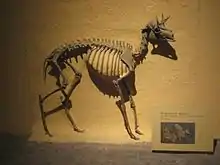Merycodontinae
Merycondontinae is a subfamily of pronghorn that arose during the middle of the Miocene and became extinct by the end of that period.
| Merycodontinae | |
|---|---|
 | |
| Merycodus | |
| Scientific classification | |
| Domain: | Eukaryota |
| Kingdom: | Animalia |
| Phylum: | Chordata |
| Class: | Mammalia |
| Order: | Artiodactyla |
| Family: | Antilocapridae |
| Subfamily: | †Merycodontinae |
| Genera | |
The Merycondontinae were small, slightly built, fast-running ungulates. Both males and females were horned.
The genera Meryceros and Submeryceros are generally regarded as synonymous with Merycodus.[1][2]
References
- Janis, Kathleen M. (1998). Evolution of Tertiary Mammals of North America: Volume 1, Terrestrial Carnivores, Ungulates, and Ungulate Like Mammals. Cambridge University Press. p. 496.
- Prothero, Donald R. (2007). The Evolution of Artiodactyls. Johns Hopkins University Press. p. 232. ISBN 9780801887352.
- Byers, John A.; American Pronghorn: Social Adaptations & the Ghosts of Predators Past; University of Chicago Press; 1998
This article is issued from Wikipedia. The text is licensed under Creative Commons - Attribution - Sharealike. Additional terms may apply for the media files.
